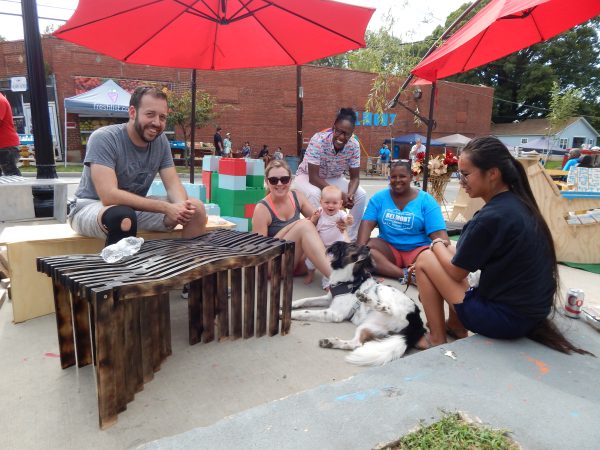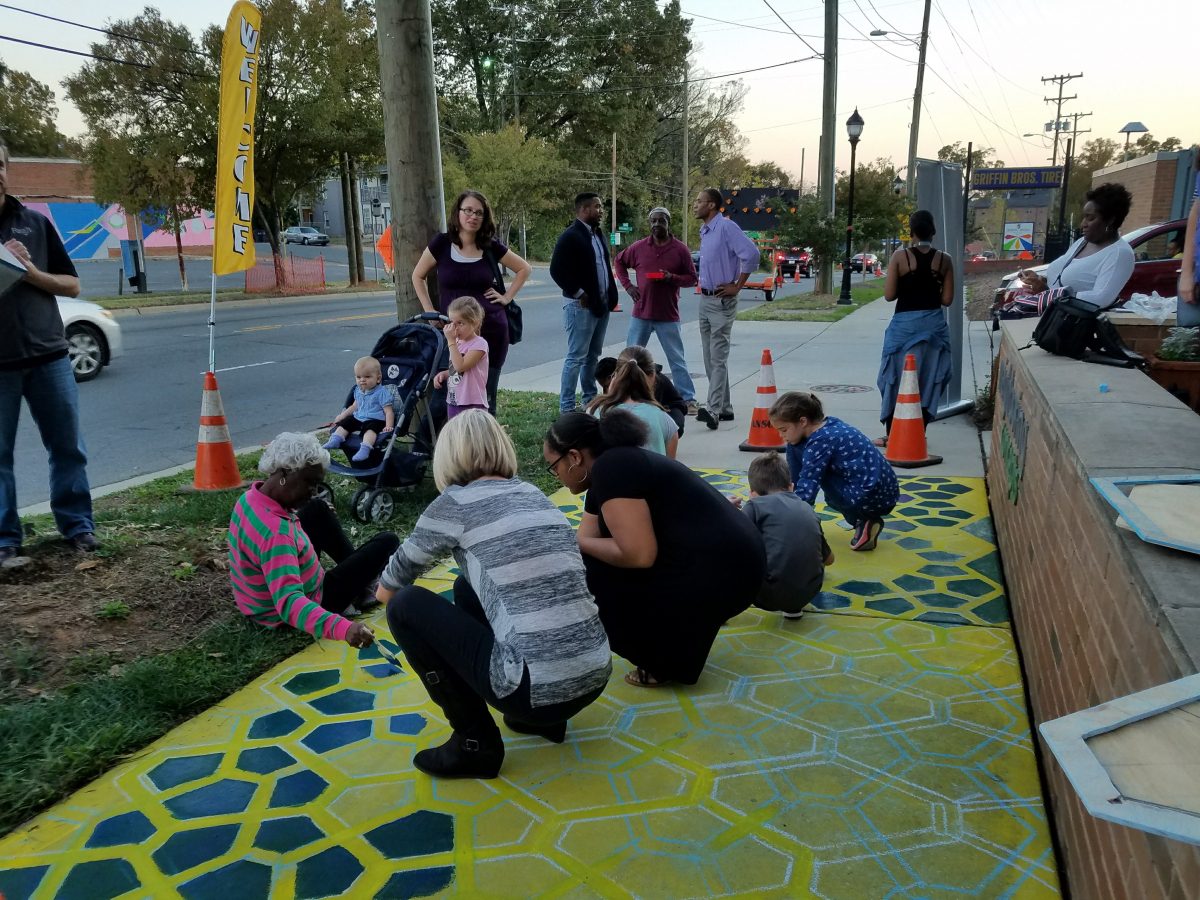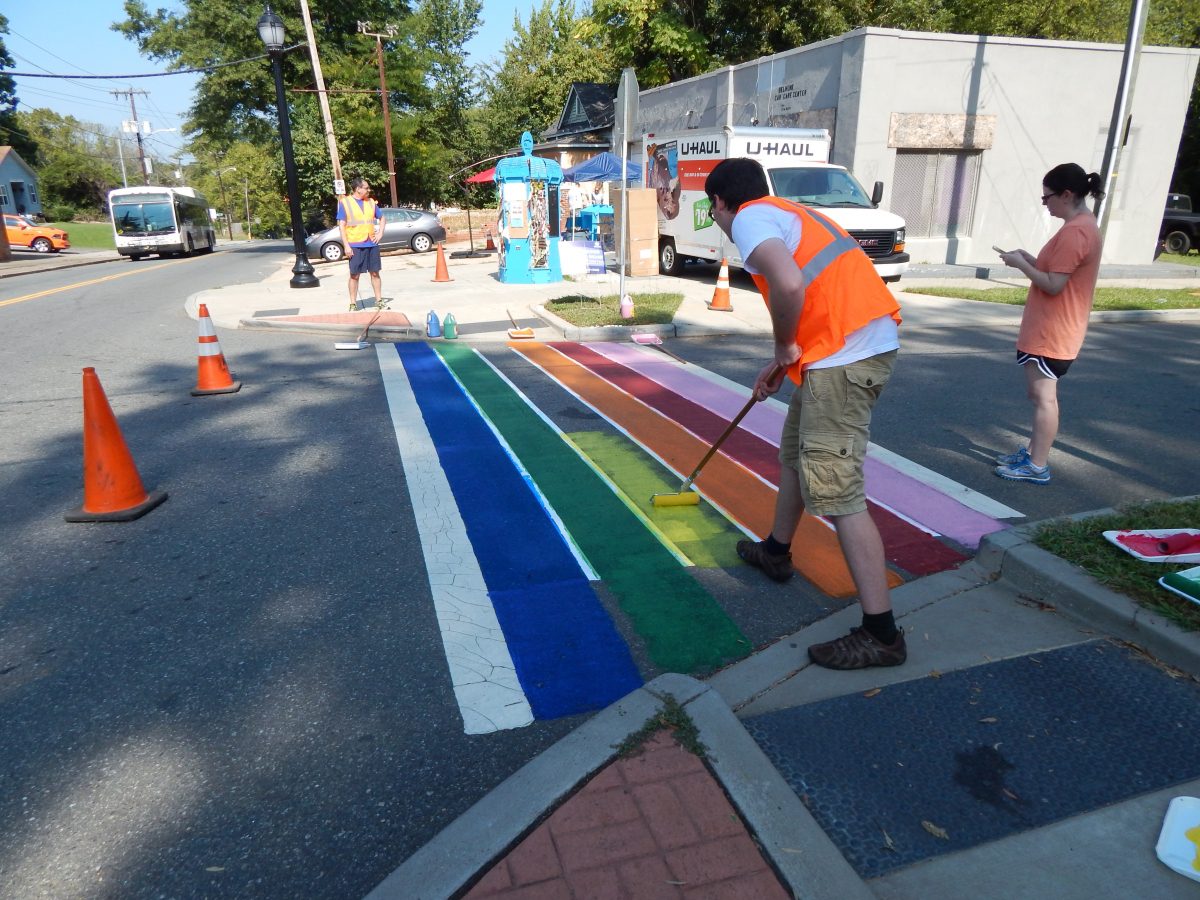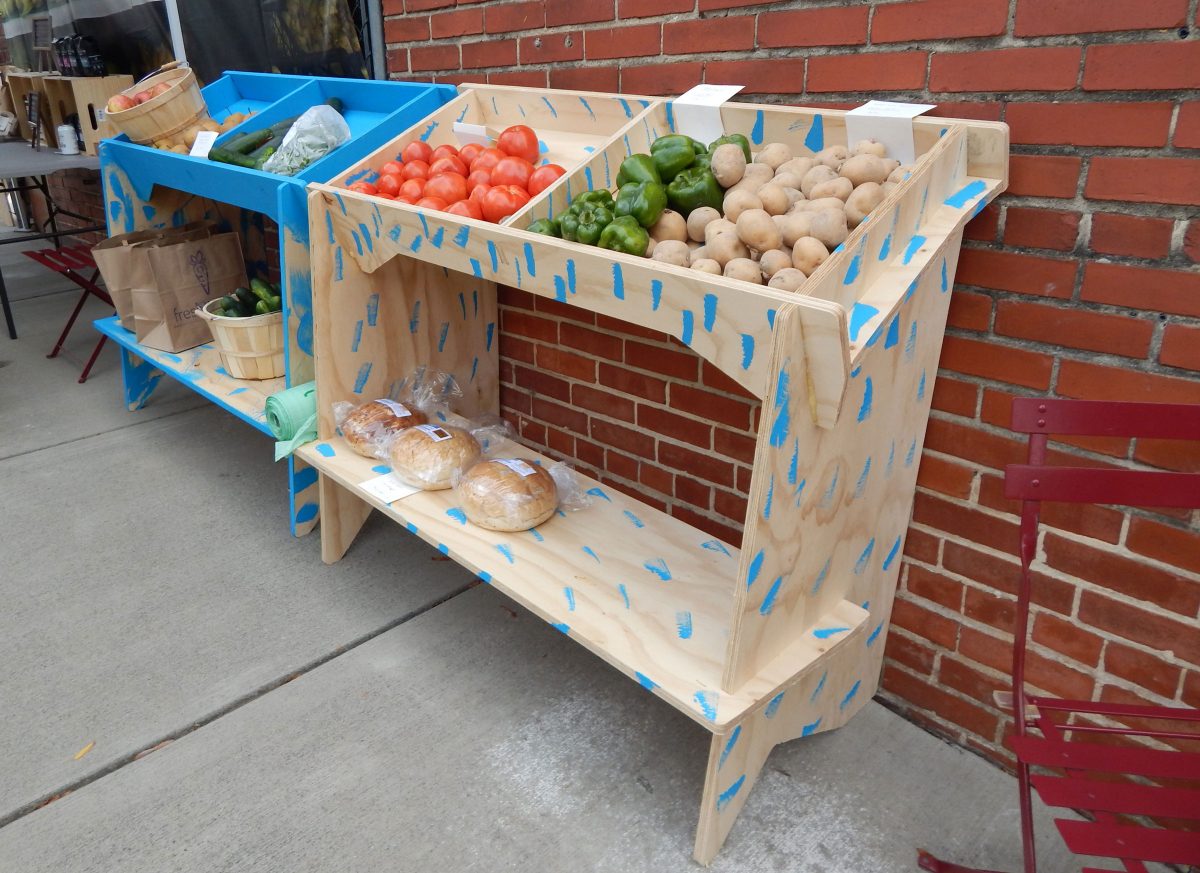Five Points, like Belmont, to get taste of tactical urbanism

If you drove down Belmont Avenue during one weekend in late September, you might have seen people in orange vests painting chairs, tables, kiosks – even crosswalks. They had come out to begin the transformation of Belmont Avenue. Community members, project leaders and employees of the nonprofit Better Block Foundation had come together to create the Belmont Avenue Better Block event Sept. 23-24.
| Information about the Five Points Better Block event, including how to volunteer. |
Vendors, including a pop-up grocery, set up outside the old Farrar grocery store at Belmont and Harrill Street, selling fruits, vegetables and other local products. A community living room sprang up outdoors, with chairs, tables, magazine and newspaper stands, umbrellas for shade and a coffee shop. Other offerings included food trucks, craft brewers, and a local artist partnering with residents to paint a mural.
The event, which sprang from a visit in July by Better Block founder Jason Roberts, reflected results of a survey of Belmont neighbors and was funded in part through a grant from the City of Charlotte. Roberts’ visit was part of a collaboration called Building Community: People + Places + Partners, a coalition of the City of Charlotte, Charlotte Center City Partners, the John S. and James L. Knight Foundation and the UNC Charlotte Urban Institute.
Next neighborhood on the agenda: the Five Points area at Johnson C. Smith University.
 Volunteers at this Nov. 3 Porch Party were getting ready for the Nov. 18 event at Five Points. Photo: Eric Orozco
Volunteers at this Nov. 3 Porch Party were getting ready for the Nov. 18 event at Five Points. Photo: Eric Orozco
Residents and businesses in the area are organizing for a Nov. 18 Five Points Better Block event, 10 a.m.-3 p.m. In addition, volunteers will be working to set it up on Friday, Nov. 17, and the plaza where the five streets converge to form Five Points will have activities from 5 p.m. to 10 p.m. Friday.
Planning for the event is ongoing but according to Eric Orozco of the planning and design firm Neighboring Concepts and one of the organizers, look for, among other things:
- Games, activities for kids, gathering areas and storefront and sidewalk embellishments along Rozzelles Ferry Road.
- A bandshell at the dead end of State Street, showcasing local talent with open mic performances
- Pop-up shops for local businesses in many places, including in vacant storefronts and around the bus stop.
- Tent spaces for local organizations.
- An interactive children’s village run by the nonprofit West Side CLT Community Land Trust.
- Enhanced sidewalks on Beatties Ford Road and West Trade Street.
- A Food Truck Mini-Rally Cookout Celebration at the FAM (former A&P Store) from 4 p.m. to 7 p.m. will conclude the Better Block event.
Five committees are helping plan and lead the Five Points Better Block events:
- Volunteers + Engagement Committee, led by J’Tanya Adams, Ronald Ross and Shannon Hughes.
- Programming + Vendors Committee led by Kia Moore and William Hughes.
- Materials + Creations Committee led by T’Afo Feimster.
- Marketing + Fundraising Committee led by Paul VanGundy.
- JCSU Student Activities Committee led by Krysta Wilson, Kyera Spivey, Denise Ball, and Mattie Marshall.
In addition to Orozco and the above committees, other coordinators include Alysia Osborne from the Historic West End Initiative and her colleagues at Charlotte Center City Partners.
 As part of the Belmont Better Block event in September, colorful pedestrian crosswalks were painted on the streets. Photo: Lela Ijames
As part of the Belmont Better Block event in September, colorful pedestrian crosswalks were painted on the streets. Photo: Lela Ijames
The idea underlying the Better Block events and the Building Community initiative is to help residents and leaders in Charlotte neighborhoods better capitalize on the assets in their community. Building Community focuses on the built environment – streets, buildings, sidewalks and parks and how they relate to each other. It’s a way to show the connection between a great built environment and a city that works for all residents, not for only the wealthy or those with automobiles.
The two neighborhoods chosen are in transition. Belmont was built in the late 1800s as a neighborhood for workers at three nearby textile mills during Charlotte’s booming textile heyday. During the days of Jim Crow racial segregation, Belmont was almost all-white; as late as 1962 no black residents were listed in the neighborhood. But Urban Renewal in the 1970s changed all that. The city demolished uptown’s Second Ward neighborhood, known as Brooklyn, as well as many homes in First Ward, without building any replacement housing. So the black residents who were displaced found homes in nearby neighborhoods such as Belmont and the previously predominantly white neighborhoods of Wilmore and Villa Heights and, in the Five Points area, Wesley Heights, Seversville and Smallwood.
White residents began moving out. By 1985, the vast majority of the Belmont population was black. The neighborhood struggled with low incomes and high crime rates.
But that started changing – again. The last decade has seen more white residents moving into the neighborhood, attracted by the historic homes, the walkable streets and proximity to uptown and the Plaza Midwood neighborhood.
According to the city-county Quality of Life Explorer, in 2002 whites made up 4.1 percent of the Belmont neighborhood’s population, while in 2010 whites made up 9.9 percent of the population. The average house value increased from $68,871 in 2002 to $129,485 in 2010. Many fear that lower income residents will be forced out by rising rents and housing costs.
A similar pattern is taking place in parts of Five Points, which takes its name from the convergence of West Trade, West Fifth and State streets and Rozelles Ferry and Beatties Ford roads. Nearby are several distinct neighborhoods, including Biddleville, the city’s oldest historically black neighborhood.
But nearby Wesley Heights, Seversville and Smallwood have histories akin to Belmont – built originally for white workers, then transitioning to black during Urban Renewal and the building of interstates 77, 85 and 277. And today, again, white residents are moving in, and moving into historically black Biddleville. (See “White people in Biddleville: The story of a changing neighborhood.”)
As those neighborhoods and others see change, the Better Block initiative aims to be one way residents can take active roles in improving their community. Regardless of how the demographics change, organizers hope to show that building an environment that caters to everyone – regardless of income, race, age or length of residence in the neighborhood – means all will be better served.
Lela Moore Ijames is a master’s degree student in the Gerald G. Fox Master of Public Administration Program at UNC Charlotte. She is working for the UNC Charlotte Urban Institute as part of the Building Community: People + Places + Partners project.
 Local produce for sale at the Belmont Better Block event in September. Organizers of the Five Points Better Block on Nov. 18 hope to offer lots of pop-up retail spaces like this one. Photo: Lela Ijames
Local produce for sale at the Belmont Better Block event in September. Organizers of the Five Points Better Block on Nov. 18 hope to offer lots of pop-up retail spaces like this one. Photo: Lela Ijames
Lela Ijames